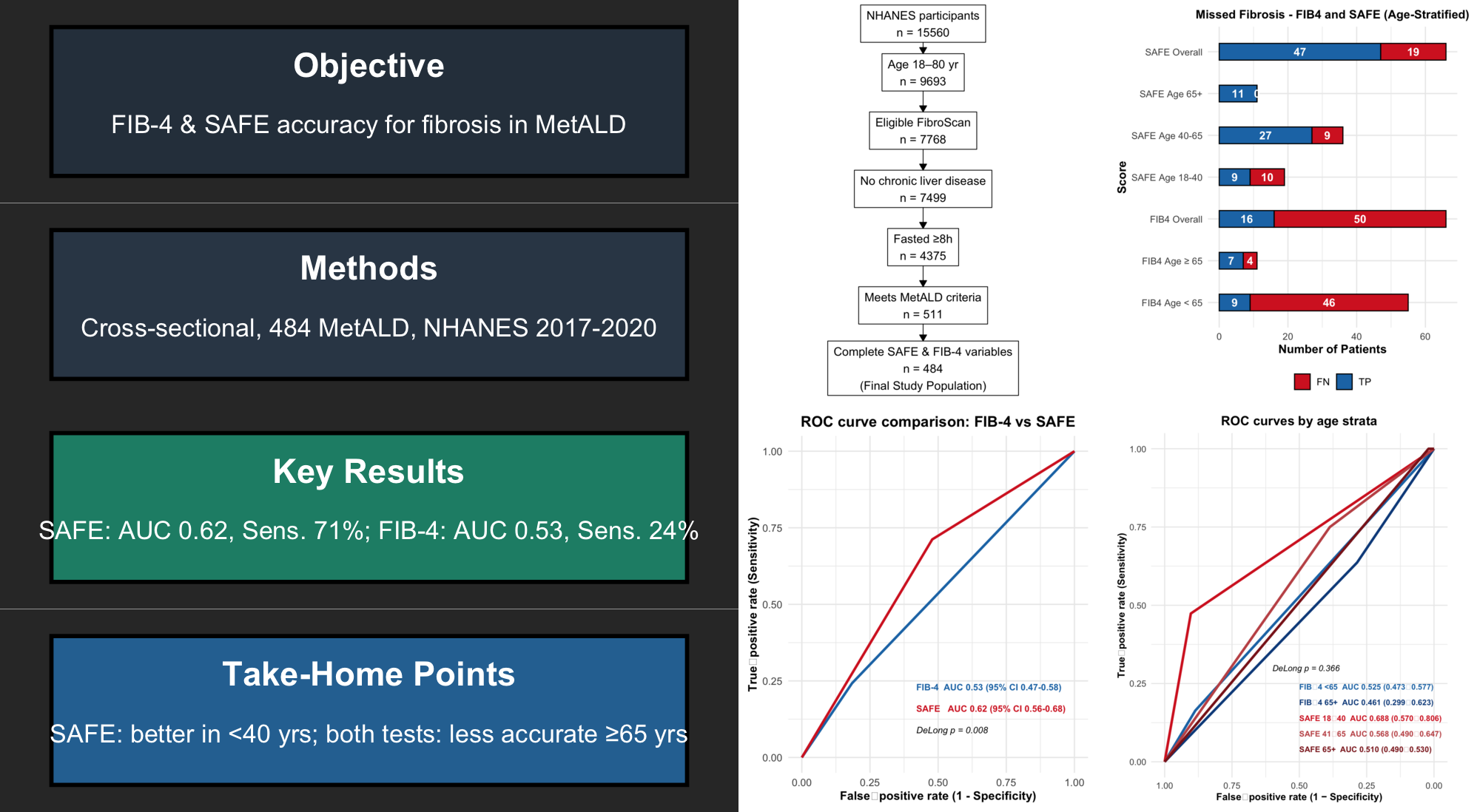Sunday Poster Session
Category: Liver
P1501 - Diagnostic Accuracy of FIB‑4 and SAFE for Detecting Fibrosis in MetALD: A Cross-Sectional NHANES Study
Sunday, October 26, 2025
3:30 PM - 7:00 PM PDT
Location: Exhibit Hall

Adem Aydin, MD (he/him/his)
Saint Mary's Hospital
Chehire, CT
Presenting Author(s)
Adem Aydin, MD1, Seyma Bilgin, MD2, Yucel Aydin, MD3
1Saint Mary's Hospital, Chehire, CT; 2Saint Mary's Hospital, Berlin, CT; 3Tulane University, New Orleans, LA
Introduction: Metabolic dysfunction–associated alcohol‑related liver disease (MetALD) is characterized by hepatic steatosis, metabolic risk factors, and moderate alcohol intake.Simple blood-based scores like FIB‑4 and SAFE may serve as first-line screening tools, but their diagnostic performance in MetALD is unclear. This study aimed to evaluate the accuracy of FIB‑4 and SAFE for detecting clinically significant fibrosis in a nationally representative cohort.
Methods: We conducted a cross-sectional analysis using data from the 2017–2020 National Health and Nutrition Examination Survey (NHANES). MetALD was defined as hepatic steatosis (CAP ≥ 288 dB/m), at least one cardiometabolic risk factor, and moderate alcohol intake (20–50 g/day for women, 30–60 g/day for men). FIB‑4 (< 1.3 = negative) and SAFE (< 0 = negative) were assessed against significant fibrosis (LSM ≥ 8 kPa). Diagnostic accuracy was expressed as sensitivity, specificity, PPV, NPV, and ROC curves. AUCs were compared using DeLong’s test. Generative AI tools (ChatGPT models O1, O3) were used to assist with code development, data visualization, and proofreading.
Results: A total of 484 participants met MetALD criteria, with a mean age of 47 ± 15 years; 47 % were men. Clinically significant fibrosis was present in 66 (13.6 %) participants. SAFE demonstrated higher sensitivity (71 %) but lower specificity (52 %) compared to FIB‑4 (24 % sensitivity, 82 % specificity). The overall AUC for SAFE was 0.617 (95 % CI 0.557–0.677) versus 0.529 (0.474–0.584) for FIB‑4 (DeLong p = 0.008). Age stratification showed that SAFE performed better in young adults (AUC 0.688 for 18–40 years) but not in older groups (AUC 0.568 for 41–65 years, 0.510 for ≥ 65 years). FIB‑4 showed poor discrimination across all age strata.
Discussion: SAFE outperformed FIB‑4 overall in detecting significant fibrosis in MetALD, particularly in younger adults. However, both tests lost accuracy in older populations, highlighting the need for age-specific or multivariable non-invasive strategies. SAFE may be a reasonable first-line rule-out tool for younger individuals where elastography is not accessible.

Figure: Summary of Study Findings
Disclosures:
Adem Aydin indicated no relevant financial relationships.
Seyma Bilgin indicated no relevant financial relationships.
Yucel Aydin indicated no relevant financial relationships.
Adem Aydin, MD1, Seyma Bilgin, MD2, Yucel Aydin, MD3. P1501 - Diagnostic Accuracy of FIB‑4 and SAFE for Detecting Fibrosis in MetALD: A Cross-Sectional NHANES Study, ACG 2025 Annual Scientific Meeting Abstracts. Phoenix, AZ: American College of Gastroenterology.
1Saint Mary's Hospital, Chehire, CT; 2Saint Mary's Hospital, Berlin, CT; 3Tulane University, New Orleans, LA
Introduction: Metabolic dysfunction–associated alcohol‑related liver disease (MetALD) is characterized by hepatic steatosis, metabolic risk factors, and moderate alcohol intake.Simple blood-based scores like FIB‑4 and SAFE may serve as first-line screening tools, but their diagnostic performance in MetALD is unclear. This study aimed to evaluate the accuracy of FIB‑4 and SAFE for detecting clinically significant fibrosis in a nationally representative cohort.
Methods: We conducted a cross-sectional analysis using data from the 2017–2020 National Health and Nutrition Examination Survey (NHANES). MetALD was defined as hepatic steatosis (CAP ≥ 288 dB/m), at least one cardiometabolic risk factor, and moderate alcohol intake (20–50 g/day for women, 30–60 g/day for men). FIB‑4 (< 1.3 = negative) and SAFE (< 0 = negative) were assessed against significant fibrosis (LSM ≥ 8 kPa). Diagnostic accuracy was expressed as sensitivity, specificity, PPV, NPV, and ROC curves. AUCs were compared using DeLong’s test. Generative AI tools (ChatGPT models O1, O3) were used to assist with code development, data visualization, and proofreading.
Results: A total of 484 participants met MetALD criteria, with a mean age of 47 ± 15 years; 47 % were men. Clinically significant fibrosis was present in 66 (13.6 %) participants. SAFE demonstrated higher sensitivity (71 %) but lower specificity (52 %) compared to FIB‑4 (24 % sensitivity, 82 % specificity). The overall AUC for SAFE was 0.617 (95 % CI 0.557–0.677) versus 0.529 (0.474–0.584) for FIB‑4 (DeLong p = 0.008). Age stratification showed that SAFE performed better in young adults (AUC 0.688 for 18–40 years) but not in older groups (AUC 0.568 for 41–65 years, 0.510 for ≥ 65 years). FIB‑4 showed poor discrimination across all age strata.
Discussion: SAFE outperformed FIB‑4 overall in detecting significant fibrosis in MetALD, particularly in younger adults. However, both tests lost accuracy in older populations, highlighting the need for age-specific or multivariable non-invasive strategies. SAFE may be a reasonable first-line rule-out tool for younger individuals where elastography is not accessible.

Figure: Summary of Study Findings
Disclosures:
Adem Aydin indicated no relevant financial relationships.
Seyma Bilgin indicated no relevant financial relationships.
Yucel Aydin indicated no relevant financial relationships.
Adem Aydin, MD1, Seyma Bilgin, MD2, Yucel Aydin, MD3. P1501 - Diagnostic Accuracy of FIB‑4 and SAFE for Detecting Fibrosis in MetALD: A Cross-Sectional NHANES Study, ACG 2025 Annual Scientific Meeting Abstracts. Phoenix, AZ: American College of Gastroenterology.

